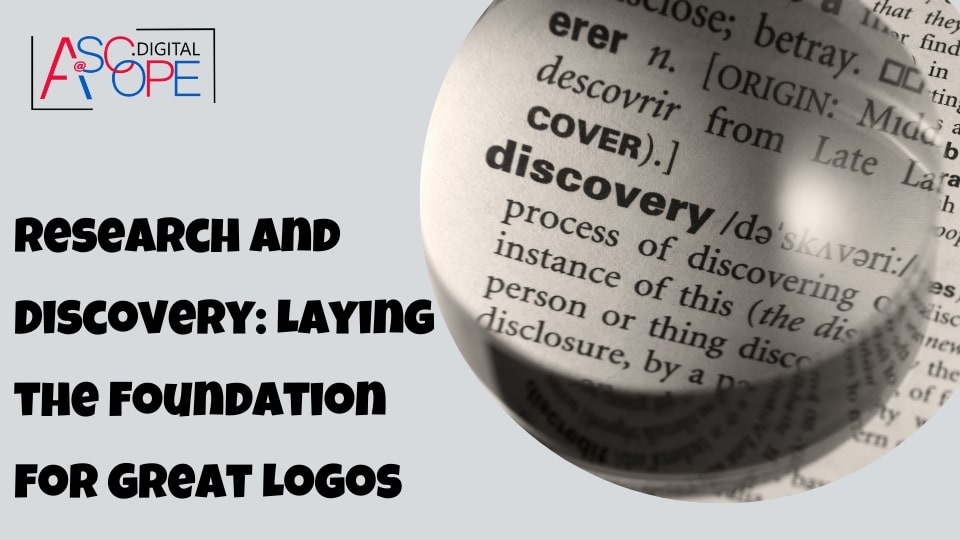Creating an effective logo is much more than just coming up with a visually appealing design. It requires a deep understanding of the brand, its target audience, and the industry it operates in. The research and discovery phase is crucial in laying the foundation for a great logo. This comprehensive guide will walk you through the essential steps in this phase, ensuring that your logo design is not only beautiful but also strategically sound.
Understanding the Brand

Before diving into any design work, it’s essential to understand the brand you’re designing for. This involves gathering detailed information about the company’s history, mission, vision, values, and overall personality. Engaging with key stakeholders through interviews and questionnaires can provide invaluable insights. Understanding the brand’s unique selling points and market position helps in crafting a logo that accurately represents its identity.
For instance, if the brand is a tech startup with a focus on innovation and cutting-edge solutions, the logo should reflect these characteristics. Conversely, a logo for a traditional and conservative law firm will require a different approach, emphasizing trust, stability, and professionalism.
Identifying the Target Audience
Knowing who the logo is intended to appeal to is as important as understanding the brand itself. The target audience’s demographics, preferences, and behaviors play a significant role in determining the design direction. A logo that resonates with the intended audience can create a stronger connection and foster brand loyalty.
Research methods such as surveys, focus groups, and market analysis can help in understanding the target audience. For example, a brand targeting millennials may benefit from a modern and minimalistic logo, while a brand aimed at children might require a more colorful and playful design.
Analyzing the Competition
A thorough competitive analysis is crucial in the research and discovery phase. Examining the logos of competitors helps in identifying industry trends and standards. It also provides insights into what works and what doesn’t, helping to avoid clichés and ensuring the new logo stands out.
Creating a competitive analysis report involves collecting logos from direct and indirect competitors and analyzing their design elements, color schemes, and typography. This analysis can reveal gaps in the market and opportunities for differentiation. For instance, if most competitors use blue in their logos, opting for a different color can make the brand more distinctive.
Defining the Design Goals
With a clear understanding of the brand, target audience, and competition, the next step is to define the design goals. These goals serve as a roadmap for the design process, ensuring that every decision aligns with the overall strategy.
Design goals should be specific, measurable, achievable, relevant, and time-bound (SMART). For example, a design goal could be to create a logo that conveys trust and reliability within three weeks. Another goal might be to develop a versatile logo that works well across various mediums, from digital to print.
Exploring Visual Inspirations

The research and discovery phase also involves gathering visual inspirations that align with the brand’s identity and design goals. This can include creating mood boards, collecting color palettes, and exploring different typography styles. Visual inspiration helps in brainstorming and refining design ideas, ensuring they are consistent with the brand’s personality.
Mood boards are particularly useful in this phase. They can include images, textures, and other design elements that evoke the desired brand feel. Sharing mood boards with stakeholders can help in aligning everyone’s vision and expectations, making the design process smoother and more collaborative.
Conceptualizing the Design
With all the research and inspiration in hand, it’s time to start conceptualizing the logo design. This phase involves sketching out initial ideas and exploring different concepts. It’s essential to keep an open mind and experiment with various design directions.
Sketching is a critical part of the conceptualization process. It allows for quick exploration of ideas and helps in visualizing different design possibilities. At this stage, it’s important not to focus too much on perfection but rather on generating a wide range of ideas. This can lead to unexpected and innovative solutions that might not have been considered otherwise.
Refining the Concepts
Once the initial sketches are done, the next step is to refine the most promising concepts. This involves selecting a few designs that best align with the brand’s identity and design goals and developing them further. Refinement includes polishing the design elements, ensuring balance and harmony, and fine-tuning details.
At this stage, digital tools such as Adobe Illustrator can be used to create vector versions of the refined sketches. This allows for precise adjustments and scalability, ensuring the logo looks great at any size. Iterative feedback from stakeholders is also crucial in this phase, helping to align the design with their vision and expectations.
Testing the Logo
Before finalizing the logo, it’s essential to test it in various contexts and applications. This includes checking how it looks on different backgrounds, at different sizes, and in both color and black-and-white versions. Testing helps in identifying any potential issues and ensures the logo is versatile and functional.
Mockups are a great way to test the logo in real-world scenarios. This can include creating business cards, website headers, social media profiles, and merchandise. Testing the logo in these contexts helps in ensuring it maintains its integrity and effectiveness across different mediums.
Finalizing the Design
After thorough testing and refinement, the final step is to finalize the logo design. This involves creating the final versions in various formats, including vector files (e.g., AI, EPS) and raster files (e.g., PNG, JPEG). Providing a comprehensive logo package with guidelines on usage helps in maintaining consistency across different applications.
The logo guidelines should include details on color codes, typography, spacing, and acceptable variations. This ensures that anyone using the logo follows the brand standards, maintaining a cohesive and professional look.
Launching the Logo
The launch of a new logo is an exciting phase that requires careful planning and execution. A well-coordinated launch can create buzz and excitement around the brand, enhancing its visibility and recognition. This can involve a teaser campaign, social media announcements, and updating all brand materials with the new logo.
Communicating the story behind the logo and the research process involved can also add value, helping the audience understand the thought and effort put into the design. This can foster a deeper connection with the brand and enhance its credibility.
Evaluating the Impact
After the logo has been launched, it’s important to evaluate its impact and performance. This involves monitoring feedback from customers, stakeholders, and the general public. Analyzing metrics such as brand recognition, customer engagement, and sales can provide insights into the logo’s effectiveness.
Continuous evaluation and feedback help in making any necessary adjustments and ensuring the logo remains relevant and effective. For example, if the logo is not resonating with the target audience as expected, minor tweaks can be made to improve its appeal.
Conclusion
The research and discovery phase is a critical step in creating a great logo. It lays the foundation for a design that is not only visually appealing but also strategically aligned with the brand’s identity and goals. By understanding the brand, target audience, and competition, defining design goals, gathering visual inspiration, conceptualizing, refining, testing, and finalizing the design, you can create a logo that truly represents the brand and resonates with its audience.
Thus, improving traffic and sales for your website. Read more on the other reasons why your website isn’t getting traffic. A well-designed logo can significantly enhance brand recognition and credibility, leading to increased traffic and sales. However, it’s important to ensure that all aspects of your website are optimized to support this growth. By addressing issues such as user experience, content quality, and SEO, you can create a holistic strategy that drives traffic and sales.
In summary, the journey to a great logo begins with thorough research and discovery. By investing time and effort in this phase, you can create a logo that not only looks great but also effectively communicates the brand’s essence and connects with its audience. This strategic approach ensures that the logo remains relevant and impactful, contributing to the brand’s long-term success.


